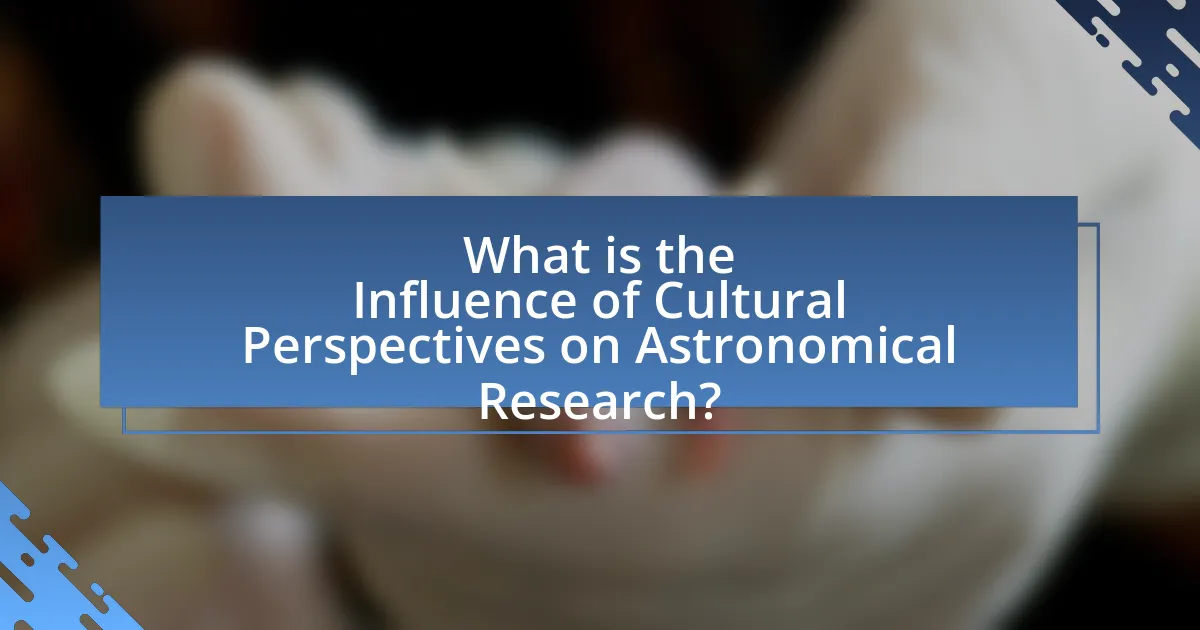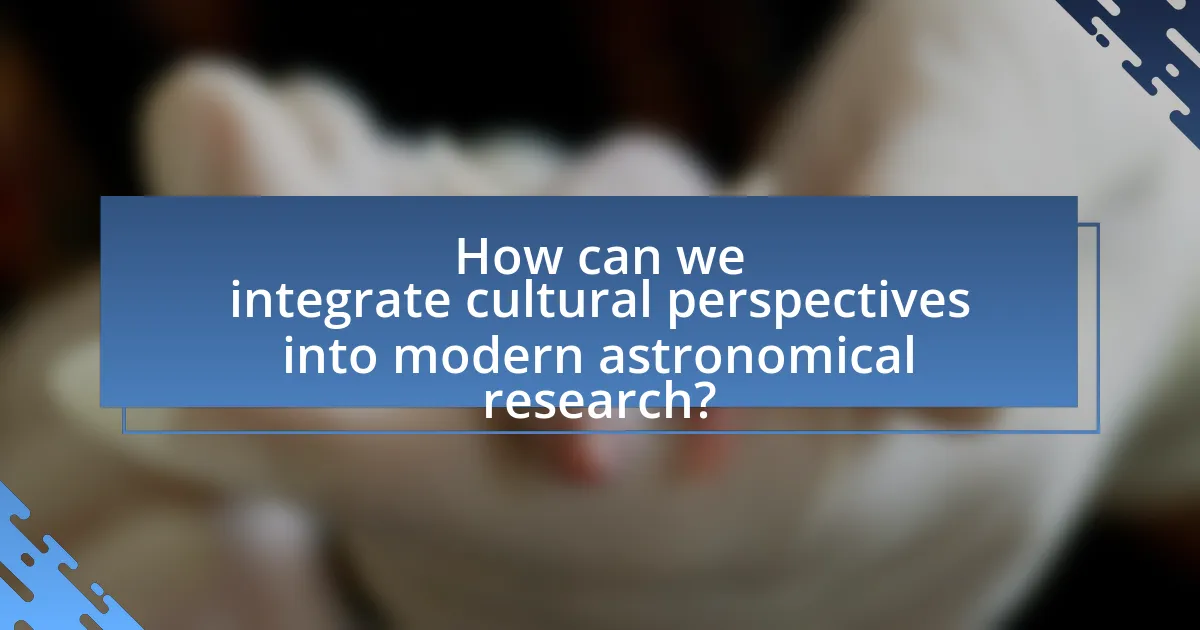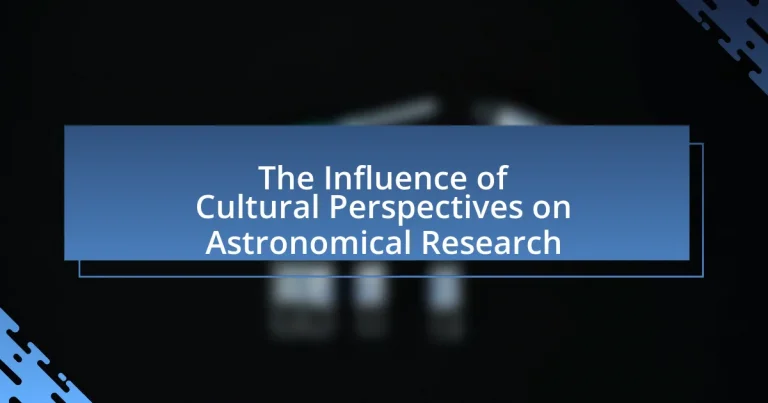The article examines the significant influence of cultural perspectives on astronomical research, highlighting how these perspectives shape research questions, methodologies, and interpretations of celestial phenomena. It discusses the integration of Indigenous astronomical knowledge with Western scientific approaches, illustrating historical examples from various cultures, including Mesopotamian and Islamic contributions. The article emphasizes the importance of considering cultural factors, such as societal values and educational systems, in shaping astronomical research priorities and interpretations. Additionally, it addresses the challenges and ethical considerations of incorporating diverse cultural insights, advocating for inclusive practices and effective cross-cultural collaboration in the field of astronomy.

What is the Influence of Cultural Perspectives on Astronomical Research?
Cultural perspectives significantly influence astronomical research by shaping the questions asked, the methodologies employed, and the interpretations of findings. For instance, Indigenous astronomical knowledge systems often prioritize observational data and celestial navigation, which can lead to different research priorities compared to Western scientific approaches that emphasize quantitative analysis and technological advancement. A study by the International Astronomical Union highlights how integrating diverse cultural viewpoints can enhance the understanding of celestial phenomena, as seen in the collaboration between Western astronomers and Indigenous communities in Australia, where traditional knowledge has informed modern astronomical practices. This integration not only enriches the scientific discourse but also fosters a more inclusive approach to understanding the universe.
How do cultural perspectives shape our understanding of astronomy?
Cultural perspectives significantly shape our understanding of astronomy by influencing the interpretation of celestial phenomena and the development of astronomical knowledge. Different cultures have historically assigned various meanings to stars and constellations, which affects how they are studied and understood. For instance, ancient Mesopotamians developed a sophisticated system of astronomy based on their agricultural calendar, while Indigenous Australian cultures have rich oral traditions that connect the stars to their ancestral stories and land. These cultural frameworks not only guide observational practices but also determine the questions asked and the significance attributed to astronomical events. This interplay between culture and astronomy illustrates that our understanding of the universe is not solely based on scientific inquiry but is also deeply rooted in cultural narratives and values.
What historical examples illustrate the impact of culture on astronomical research?
Historical examples that illustrate the impact of culture on astronomical research include the contributions of ancient Mesopotamian civilizations, which developed early astronomical records and mathematical models based on their agricultural calendar, and the work of Islamic astronomers during the Golden Age, who preserved and expanded upon Greek astronomical knowledge. The Mesopotamians created detailed star catalogs and used celestial observations to inform agricultural practices, demonstrating how their cultural needs shaped their astronomical pursuits. Similarly, Islamic scholars like Al-Battani and Al-Farghani translated and built upon Ptolemaic models, integrating cultural and religious perspectives into their work, which led to advancements in trigonometry and observational techniques. These examples underscore how cultural contexts directly influenced the development and focus of astronomical research throughout history.
How do different cultures interpret celestial phenomena?
Different cultures interpret celestial phenomena through unique mythologies, religious beliefs, and scientific frameworks. For instance, ancient Mesopotamians viewed celestial bodies as deities influencing human affairs, while Indigenous Australian cultures often see the stars as ancestral beings, guiding their social and environmental practices. In contrast, Western cultures have historically approached celestial phenomena through a scientific lens, leading to advancements in astronomy and space exploration. These interpretations are shaped by historical context, societal values, and environmental factors, demonstrating the diverse ways humanity understands the cosmos.
Why is it important to consider cultural perspectives in astronomical research?
Considering cultural perspectives in astronomical research is important because it enriches scientific understanding and fosters inclusivity. Different cultures have unique astronomical traditions and interpretations, which can provide valuable insights into celestial phenomena. For instance, Indigenous Australian astronomy incorporates knowledge of the stars that has been passed down for thousands of years, offering alternative narratives and data that can enhance contemporary astronomical studies. Acknowledging these perspectives can lead to more comprehensive research outcomes and promote collaboration between scientists and diverse communities, ultimately advancing the field of astronomy.
What are the potential biases in astronomical research without cultural considerations?
Potential biases in astronomical research without cultural considerations include a narrow focus on Western scientific paradigms, which can lead to the exclusion of diverse astronomical knowledge systems. This lack of inclusivity may result in the misinterpretation of celestial phenomena, as indigenous and non-Western cultures often possess unique insights and methodologies that differ from mainstream astronomy. For instance, the Māori of New Zealand have a rich tradition of star navigation that informs their understanding of the cosmos, which is often overlooked in conventional research. Additionally, the absence of cultural perspectives can perpetuate systemic biases, such as the underrepresentation of minority groups in astronomical studies, ultimately skewing data interpretation and limiting the scope of scientific inquiry.
How can cultural perspectives enhance scientific collaboration in astronomy?
Cultural perspectives can enhance scientific collaboration in astronomy by fostering diverse viewpoints that lead to innovative problem-solving and richer scientific discourse. When astronomers from various cultural backgrounds collaborate, they bring unique methodologies, interpretations, and questions that can challenge existing paradigms and stimulate new research avenues. For instance, the inclusion of indigenous knowledge systems has been shown to provide alternative insights into celestial navigation and environmental stewardship, which can complement traditional scientific approaches. Research indicates that interdisciplinary teams, which include diverse cultural perspectives, often produce higher-quality research outcomes, as evidenced by studies published in journals like “Nature” and “Science.” These findings underscore the importance of cultural diversity in enhancing the collaborative efforts within the field of astronomy.

What are the key cultural factors influencing astronomical research?
Key cultural factors influencing astronomical research include societal values, historical context, and educational systems. Societal values shape the priorities and funding for astronomical projects, as seen in countries that prioritize science and technology, leading to advanced research initiatives. Historical context, such as the contributions of ancient civilizations like the Babylonians and Greeks, informs contemporary methodologies and perspectives in astronomy. Additionally, educational systems impact the development of future astronomers, with countries that emphasize STEM education producing more researchers in the field. These factors collectively determine the direction and scope of astronomical research across different cultures.
How do religious beliefs affect astronomical interpretations?
Religious beliefs significantly influence astronomical interpretations by shaping the frameworks through which celestial phenomena are understood. For instance, in many cultures, religious narratives have historically provided explanations for astronomical events, such as eclipses or planetary movements, often attributing them to divine actions or omens. The ancient Mayans, for example, integrated their astronomical observations into their religious calendar, linking celestial cycles to agricultural and ritual practices. This intertwining of religion and astronomy illustrates how belief systems can dictate the significance and interpretation of astronomical data, often prioritizing spiritual meanings over empirical observations.
What role do mythologies play in shaping astronomical knowledge?
Mythologies play a significant role in shaping astronomical knowledge by providing cultural frameworks that influence how celestial phenomena are interpreted. Various civilizations have used mythological narratives to explain the movements of celestial bodies, such as the ancient Greeks attributing the changing seasons to the myth of Persephone and Demeter. These stories not only served to contextualize astronomical events but also guided early astronomers in their observations and classifications of stars and planets. For instance, the Babylonian star catalogues were deeply intertwined with their mythology, linking constellations to gods and legends, which helped in the development of early astronomical systems. Thus, mythologies have historically acted as a lens through which societies understand and organize their astronomical knowledge.
How do different religious traditions approach the study of the cosmos?
Different religious traditions approach the study of the cosmos through unique theological frameworks and cosmological narratives. For instance, in Hinduism, the cosmos is viewed as cyclical, with the universe undergoing endless cycles of creation and destruction, as described in texts like the Vedas. In contrast, Christianity often interprets the cosmos as a creation of God, emphasizing a linear progression from creation to an eventual end, as outlined in the Book of Genesis. Buddhism presents a non-theistic perspective, focusing on the impermanence of the cosmos and the interconnectedness of all beings, which is reflected in its teachings on dependent origination. These varying perspectives influence how adherents engage with astronomical phenomena, shaping their understanding of existence and the universe’s nature.
What social factors contribute to diverse astronomical perspectives?
Social factors such as cultural heritage, education, socioeconomic status, and community engagement significantly contribute to diverse astronomical perspectives. Cultural heritage shapes how different societies interpret celestial phenomena, influencing their myths, rituals, and scientific inquiries. Education systems vary globally, affecting access to astronomical knowledge and fostering different levels of interest and expertise in the field. Socioeconomic status impacts resource availability for astronomical research and education, leading to disparities in participation and representation. Community engagement initiatives, such as local astronomy clubs and outreach programs, promote inclusivity and diverse viewpoints, enriching the overall understanding of astronomy. These factors collectively create a rich tapestry of perspectives that enhance astronomical research and discourse.
How does education level influence cultural views on astronomy?
Education level significantly influences cultural views on astronomy by shaping individuals’ understanding and appreciation of scientific concepts. Higher education often correlates with increased exposure to scientific methodologies and critical thinking skills, leading to a more favorable view of astronomy as a legitimate field of study. For instance, studies show that individuals with advanced degrees are more likely to engage with and support scientific initiatives, including astronomical research, compared to those with lower educational attainment. This trend is evident in surveys indicating that college-educated individuals tend to have a greater interest in space exploration and a stronger belief in the importance of scientific literacy, which directly impacts cultural attitudes towards astronomy.
What impact do community values have on astronomical research priorities?
Community values significantly shape astronomical research priorities by influencing funding decisions, research focus, and public engagement. For instance, communities that prioritize environmental sustainability may advocate for research on exoplanets and their potential habitability, leading institutions to allocate resources accordingly. Additionally, cultural perspectives can drive interest in specific astronomical phenomena, such as indigenous astronomical knowledge, which can result in collaborative projects that integrate traditional knowledge with modern science. This alignment of research priorities with community values is evident in initiatives like the International Dark-Sky Association, which promotes research on light pollution, reflecting a community-driven concern for preserving night skies.

How can we integrate cultural perspectives into modern astronomical research?
Integrating cultural perspectives into modern astronomical research can be achieved by incorporating indigenous knowledge systems and collaborating with diverse cultural communities. This approach acknowledges that many cultures have rich astronomical traditions and insights that can enhance scientific understanding. For instance, the use of traditional ecological knowledge (TEK) has been shown to provide valuable context for celestial events and phenomena, as evidenced by studies that highlight the alignment of indigenous star maps with contemporary astronomical data. Engaging with cultural narratives and practices not only enriches research but also fosters inclusivity and respect for diverse worldviews in the scientific community.
What methodologies can be employed to incorporate cultural insights?
Qualitative research methodologies, such as ethnography and participatory action research, can be employed to incorporate cultural insights. Ethnography allows researchers to immerse themselves in different cultural contexts, gaining a deep understanding of local beliefs and practices related to astronomy. Participatory action research involves collaboration with community members, ensuring that their cultural perspectives are integrated into the research process. These methodologies have been validated by studies demonstrating that culturally informed approaches lead to more relevant and effective astronomical research outcomes, as seen in the work of researchers like David K. H. Choi and colleagues, who emphasize the importance of cultural context in scientific inquiry.
How can interdisciplinary approaches enhance cultural integration in astronomy?
Interdisciplinary approaches can enhance cultural integration in astronomy by combining insights from various fields such as anthropology, history, and sociology with astronomical research. This integration allows for a more comprehensive understanding of how different cultures perceive and interpret celestial phenomena. For instance, studies have shown that incorporating indigenous knowledge systems into astronomical education can foster greater appreciation and respect for diverse cultural perspectives, as evidenced by programs that integrate traditional star lore with modern astronomy curricula. Such collaborations not only enrich scientific inquiry but also promote inclusivity and cultural sensitivity within the field, ultimately leading to a more holistic view of the universe that acknowledges and values diverse cultural contributions.
What role do community engagement and outreach play in this integration?
Community engagement and outreach are essential for integrating cultural perspectives into astronomical research. These activities foster collaboration between researchers and diverse communities, ensuring that various cultural viewpoints are represented and valued in scientific discourse. For instance, outreach programs that involve local communities can lead to the incorporation of indigenous knowledge systems, which may offer unique insights into celestial phenomena. Research has shown that inclusive practices in science not only enhance the relevance of findings but also promote public interest and investment in scientific endeavors, as evidenced by initiatives like the International Astronomical Union’s efforts to engage underrepresented groups in astronomy.
What are the challenges of integrating cultural perspectives in astronomy?
Integrating cultural perspectives in astronomy faces several challenges, primarily due to differing worldviews and knowledge systems. These challenges include the potential for conflict between scientific and traditional beliefs, as seen in cases where indigenous cosmologies contradict established astronomical theories. Additionally, there is often a lack of representation of diverse cultural voices in mainstream astronomical research, which can lead to the marginalization of valuable insights. Furthermore, language barriers and differing terminologies can hinder effective communication and collaboration between cultures. These factors collectively complicate the integration of cultural perspectives into the field of astronomy, limiting the potential for a more holistic understanding of the universe.
How can researchers overcome resistance to cultural integration?
Researchers can overcome resistance to cultural integration by actively engaging with diverse cultural perspectives and fostering inclusive dialogue. This approach involves creating collaborative environments where researchers from various backgrounds can share their insights and experiences, thereby enriching the research process. Evidence from studies, such as the 2018 report by the National Science Foundation, indicates that diverse teams produce more innovative solutions and enhance problem-solving capabilities. By prioritizing cultural sensitivity and understanding, researchers can effectively bridge gaps and facilitate smoother integration of cultural perspectives in astronomical research.
What ethical considerations arise when incorporating cultural perspectives?
Incorporating cultural perspectives in astronomical research raises ethical considerations such as cultural appropriation, representation, and respect for indigenous knowledge systems. Cultural appropriation occurs when elements of a culture are used without permission or understanding, potentially leading to misrepresentation and exploitation. Representation is crucial, as marginalized communities may have unique insights into celestial phenomena that should be acknowledged and integrated respectfully. Additionally, respecting indigenous knowledge systems involves recognizing the validity of traditional astronomical practices and beliefs, which can enhance scientific understanding. These considerations are essential to ensure that cultural perspectives are integrated ethically and meaningfully into astronomical research.
What best practices can astronomers adopt to respect cultural perspectives?
Astronomers can adopt best practices such as engaging with Indigenous communities, incorporating traditional ecological knowledge, and ensuring cultural sensitivity in research. Engaging with Indigenous communities allows astronomers to understand local cultural beliefs and practices related to astronomy, fostering collaboration and mutual respect. Incorporating traditional ecological knowledge can enhance scientific understanding and promote sustainable practices, as seen in various studies where Indigenous insights have contributed to environmental conservation efforts. Ensuring cultural sensitivity involves recognizing and respecting sacred sites and celestial bodies that hold significance for different cultures, which can be achieved through consultations and ethical guidelines in research protocols.
How can astronomers ensure inclusivity in their research practices?
Astronomers can ensure inclusivity in their research practices by actively engaging diverse communities and incorporating varied cultural perspectives into their work. This can be achieved through collaborative projects that involve underrepresented groups, fostering an environment where different viewpoints are valued and integrated into research methodologies. For instance, initiatives like the National Science Foundation’s Astronomy and Astrophysics Research Grants encourage proposals that include outreach to diverse populations, demonstrating a commitment to inclusivity. Additionally, training programs focused on cultural competency can help astronomers understand and respect the contributions of various cultural backgrounds, ultimately enriching the scientific discourse and broadening the impact of astronomical research.
What strategies can be implemented for effective cross-cultural collaboration?
Effective cross-cultural collaboration can be achieved through strategies such as fostering open communication, promoting cultural awareness, and establishing common goals. Open communication encourages team members to express their ideas and concerns, which is essential for understanding diverse perspectives. Promoting cultural awareness involves educating team members about each other’s cultural backgrounds, which can reduce misunderstandings and build respect. Establishing common goals aligns the efforts of individuals from different cultures towards a shared objective, enhancing teamwork and collaboration. Research indicates that teams with high cultural awareness and clear communication channels are more successful in achieving their objectives, as evidenced by studies in international business settings that show improved performance metrics when these strategies are employed.


